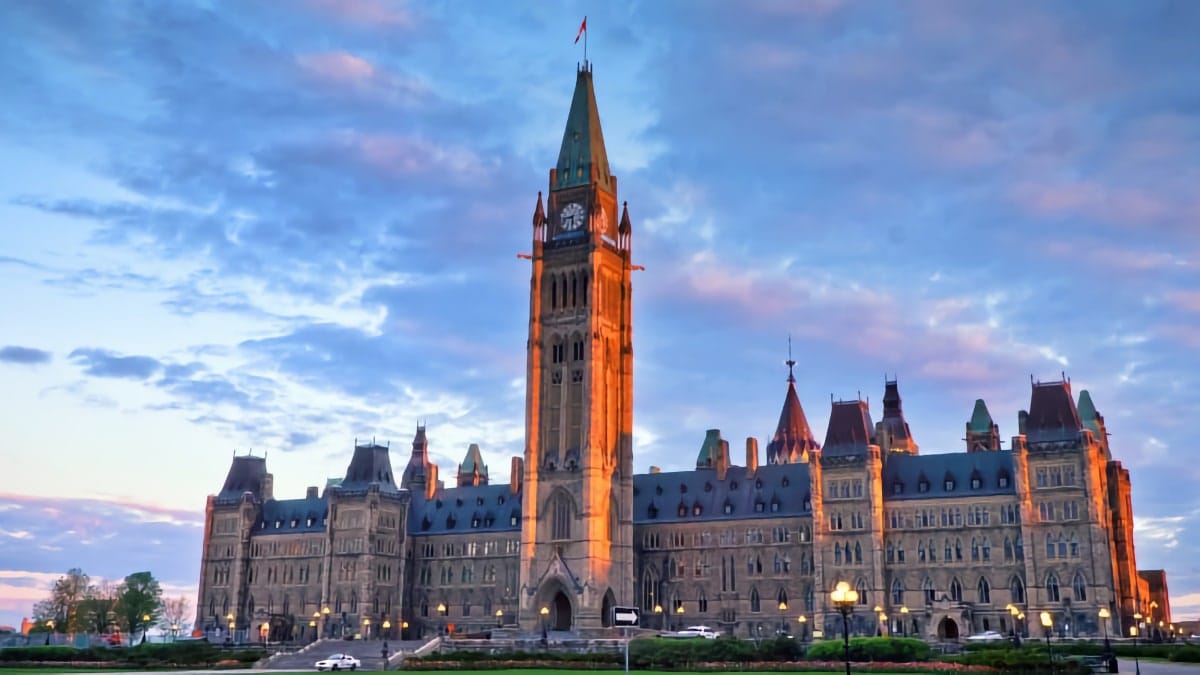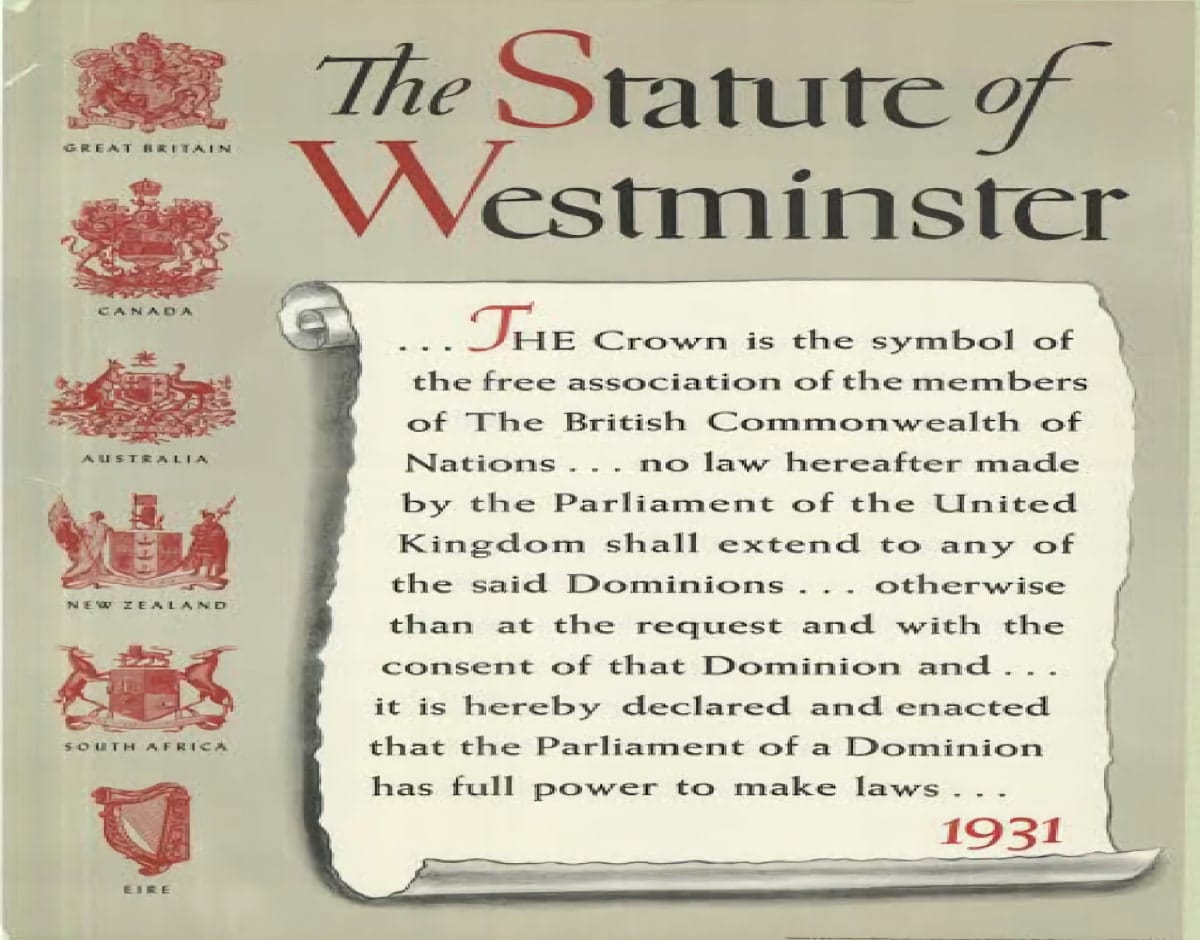Statute of Westminster Day

A CANADIAN CROWN
If you walk past a Canadian government building on any 11 December, you may be surprised to see the Royal Union Flag (popularly, the Union Jack) flying alongside the Maple Leaf. That's because 11 December 1931 is Statute of Westminster Day.
“What the hell is the that?” you may well ask. Canada Day celebrates Confederation in 1867, and there's a natural tendency to think that got us to where we are now. And yet, 1931 contributed almost as much to our national development.
When the dominions (Canada, Australia, New Zealand, South Africa…) were formed in the 19th and early 20th Centuries they were more self-governing provinces of the British Empire than independent states in their own right. The parliament in Westminster retained a veto power over any act of the dominion parliaments and centralized control over all imperial foreign policy. These were considered essential measures to preserve the unity of the empire against its foreign rivals (and their knavish tricks!).
Such a limited form of nationhood wasn’t just acceptable to the dominions; it was welcomed. As member states of the British Empire they played a significant role on the world stage; by themselves they would have been insignificant minor powers. A lot of interesting work has been done on the nature of Canadian patriotism in the 19th Century and its tendency to express itself in the form of imperial boosterism (rabidly for anglophones but even, to some extent, for francophones).
War changed all that. The dominions mobilized completely for World War One, remaking their societies and economies to meet its ever increasing demands. Both Canada and Australia eventually contributed complete corps-sized forces to the western front. These fought as distinct national formations and performed as well (often better) than any British corps. After so much sacrifice and effort, a subordinate national status was unacceptable. Letters and contemporary accounts from Canada’s overseas soldiers tell a remarkable story of how four years of blood and hard-won accomplishment created a distinct sense of national identity and pride within the Canadian Corps.

To its credit, Britain recognized the dominions’ contributions and lobbied for them to have their own seats at the Versailles peace conference, rather than be included within the British delegation. (The United States argued vehemently against this at the time — on the basis that it was just a trick to get more British votes!).
The newfound maturity of the dominions remained a prime topic as the dominion and British heads of government met at the Imperial Conferences of 1926 and 1930. Their efforts were realized when the British parliament passed the Statute of Westminster In 1931. This formalized a new relationship within what was still called the British Empire. Essentially, it separated the crowns of the dominions from the Crown of the United Kingdom, creating separate heads of state for each, and putting each dominion parliament on an equal footing with Westminster.
Thus, it ended the British veto over the dominion parliaments, along with British control of a centralized foreign policy. Effectively, the dominions became full nation states (now more properly styled as realms). It is proper from this point to refer to the dominion sovereigns as the King or Queen of Canada (Australia, New Zealand, etc) as they were now distinct legal personages from the sovereign of the United Kingdom.
Enabling legislation followed in most of the dominion parliaments. Newfoundland bowed out because of its longstanding financial difficulties, and the Irish Free State barely paused on its road to full independence as a republic. But, with the exception of South Africa (booted out during apartheid), the rest of the dominions who attended those conferences are still joined by the shared monarchy they created in 1931.
Thus, the Statute (and its accompanying national legislation) remains relevant to this day. It is the foundation of the Commonwealth Realm – an inner group within the Commonwealth of Nations — that share Charles III as sovereign and head of state. Membership has even grown in recent decades as some former British possessions have achieved self-government.
A final aside: it’s amazing to me that so much of the national development of this supposedly unmilitary nation has been the consequence of war. Just as there is a direct line from Canada’s sacrifices and accomplishments in WWI to the Statute of Westminster, Canada’s enormous contribution to victory in WWII set the stage for the next step: the passage of the Citizenship Act, 1946. This established a legal status for Canadian Citizenship, separate from that of British Subject. Since then, Canadians have been citizens of Canada and not — as before — merely British Subjects resident in Canada. The only development of similar importance since is the patriation of the constitution in 1982. It may be a sign of progress that this was managed without a preceding war…
Fun Facts: Now you can how wrong it is to complain about Canada being “ruled by the King of England!” There are three mistakes in that short statement:
- In a constitutional monarchy the sovereign reigns but does not rule (the democratically elected governments rules);
- There has not been a King or Queen of England since 1707, when Queen Anne signed the Act of Union joining the crowns of Scotland and England into a United Kingdom; and
- Since the passage of the Statute of Westminster our head of state has been the Queen (now King) of Canada (a separate legal figure from the British monarch, even though both are the same physical person).